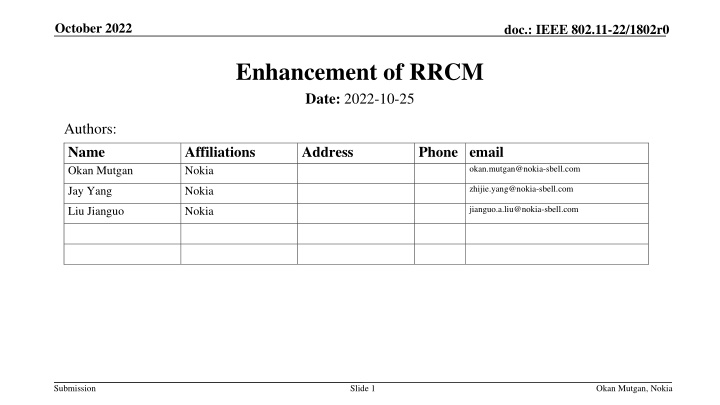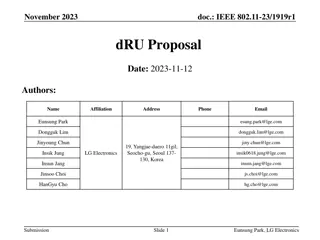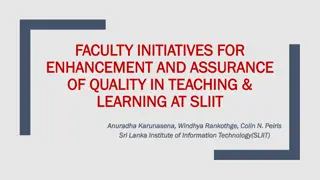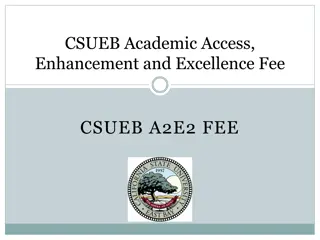Enhancement of Rule-based Random and Changing MAC Proposal in IEEE 802.11-22/1802r0
This document details the enhancements proposed for the Rule-based Random and Changing MAC (RRCM) in IEEE 802.11-22/1802r0. The RRCM concept involves generating Random MAC (RMA) addresses locally to increase security and prevent trackability in wireless networks. Key aspects include RMA generation, usage in association, concerns regarding MAC address exposure, and similarities with 802.11w Protected Management Frames (PMF).
Download Presentation

Please find below an Image/Link to download the presentation.
The content on the website is provided AS IS for your information and personal use only. It may not be sold, licensed, or shared on other websites without obtaining consent from the author.If you encounter any issues during the download, it is possible that the publisher has removed the file from their server.
You are allowed to download the files provided on this website for personal or commercial use, subject to the condition that they are used lawfully. All files are the property of their respective owners.
The content on the website is provided AS IS for your information and personal use only. It may not be sold, licensed, or shared on other websites without obtaining consent from the author.
E N D
Presentation Transcript
October 2022 doc.: IEEE 802.11-22/1802r0 Enhancement of RRCM Date: 2022-10-25 Authors: Name Okan Mutgan Affiliations Nokia Address Phone email okan.mutgan@nokia-sbell.com zhijie.yang@nokia-sbell.com Jay Yang Nokia jianguo.a.liu@nokia-sbell.com Liu Jianguo Nokia Submission Slide 1 Okan Mutgan, Nokia
October 2022 doc.: IEEE 802.11-22/1802r0 Abstract This document provides enhancement of the current Rule-based Random and Changing MAC (RRCM) proposal 818/r4 Submission Slide 2 Okan Mutgan, Nokia
October 2022 doc.: IEEE 802.11-22/1802r0 Recap-1 The main idea of current RRCM is that each side (non-AP STA and AP) locally generates the same Random MAC - RMA (that is used by the non- AP STA in next association(s)) based on the same formula and parameters. STA and AP generate one or more RMA(s) locally at their sides using, - Key (RMA key) locally generated private key - Seed exchanged between two sides to feed into RMA generation formula - Counter exchanged between two sides to make sure both sides generate the same number of RMA(s) The STA will use the generated RMA(s) in its next association. Since AP also generates the same RMA(s), it will identify the STA. If STA generates a single RMA -> STA can use it in all message exchanges If STA generates multiple RMA(s) -> STA can use them in different message exchanges (e.g. RMA1 in probe request frame, RMA2 in other frames). Submission Slide 3 Okan Mutgan, Nokia
October 2022 doc.: IEEE 802.11-22/1802r0 Recap-1 AP Non-AP STA Associate with MAC1 Generate and store a secret key locally Generate and store a secret key locally 1st Assoc Generate and store RMA(s) based on the key. (e.g. RMA1, RMA2) Generate and store RMA(s) based on the key (e.g. RMA, RMA2) Use RMA1&RMA2 (e.g. ANQP Req RMA1, Auth/Assoc/4-way HS - RMA2) 2nd Assoc Generate new RMA(s) if desired Submission Slide 4
October 2022 doc.: IEEE 802.11-22/1802r0 Recap-1 Concerns about RRCM Using MAC address (sent in the clear) exposes the identity Causes high risk of trackability -> using multiple temporary RMAs avoids these concerns to some extent Attacks are possible (e.g. replay attack, MAC spoofing) An attacker can listen to the non-AP STA or AP s frames and impersonate the non-AP STA or AP, especially in pre-association. To avoid this, we propose to make sure that the frames come from a legitimate STA and AP, when the STA returns to ESS. -> idea similar to 802.11w Protected Management Frames (PMF): Submission Slide 5
October 2022 doc.: IEEE 802.11-22/1802r0 Recap-2 802.11w Protected Management Frames (PMF) In 802.11w, when a non-AP STA associates with AP, they determine a secret key and protect the unicast/broadcast management frames as follows: Broadcast/multicast management frames are protected by MMIE (Management MIC Information Element) with IGTK. MMIE IPN (IGTK packet number) protects replay attack, MIC (Message Integrity Code) makes sure the frame is not changed (i.e. integrity ). Unicast management frames are protected by encrypting the payload (as in data frames) with PTK. Note that encrypted payload contains PN (packet number) and MIC to provide protection for replay attack and integrity. Beacon is protected by MMIE (as in broadcast management frames) but with BIGTK. Submission Slide 6 Okan Mutgan, Nokia
October 2022 doc.: IEEE 802.11-22/1802r0 Recap-2 How to protect management frames when non-AP STA returns to the same ESS? An example of 802.11w: Submission Slide 7 Okan Mutgan, Nokia
October 2022 doc.: IEEE 802.11-22/1802r0 Proposal Enhanced RRCM In the first association, 1. Non-AP STA associates with AP through common RRCM procedure: -> RMA(s) for non-AP STA are generated for future association. 2. Non-AP STA and AP determine and store a secret key to protect pre-association management frames (such as ANQP, authentication, association etc.) when non-AP STA returns (second association) [enhancement] In the second association, - Non-AP STA uses previously generated RMA(s) and gets identified by the AP. - Additionally, non-AP STA and AP send management frames protected (using previously generated secret key). [enhancement] - By doing so, both parties (non-AP STA and AP) make sure that the management frames come from a legitimate non-AP STA/AP. Submission Slide 8 Okan Mutgan, Nokia
October 2022 doc.: IEEE 802.11-22/1802r0 Proposal Enhanced RRCM How to protect management frames when non-AP STA returns to the same ESS? In enhanced RRCM, After non-AP STA associates with AP and gets identifier (RMA), non-AP STA and AP store a secret key to protect management frames when non-AP STA returns (in addition to storing generated RMA(s)). In other words, non-AP STA and AP perform 802.11w on a pre-determined secret key or 802.11w on pre-association management frames . Both parties (non-AP STA and AP) protect their management frames: Which management frames to protect? To keep it simple, some unicast management frames (such as ANQP authentication/association) can be considered, even though nothing limits the types of frames to be protected. Is the complexity too high? Because protection and identification happen at the same time, complexity is not high: The AP identifies the non-AP STA as soon as AP receives frames from non-AP STA (RMA in MAC header). Because AP identifies the non-AP STA, it knows which key to use for protection. Submission Slide 9 Okan Mutgan, Nokia
October 2022 doc.: IEEE 802.11-22/1802r0 Proposal Enhanced RRCM AP Non-AP STA Non-AP STA and AP go through RRCM: non-AP STA and AP generate and store RMA(s) for second association. 1st Assoc Non-AP STA and AP determine and store a secret key for pre-association management frame protection in future association Non-AP STA sends protected management frames (Authentication Req , Association Req) using the secret key from 1st Association. Non-AP STA also uses RMA(s) from RRCM. 2nd Assoc AP sends protected management frames (Authentication Resp , Association Resp) using the secret key from 1st Association. Submission Slide 10 Okan Mutgan, Nokia
October 2022 doc.: IEEE 802.11-22/1802r0 Proposal Enhanced RRCM AP Non-AP STA When the non-AP STA returns to the ESS, it protects its management frames (such as ANQP, authentication/association request). IE MAC Header RMA1 MAC Payload Attacker AP IPN & MIC IE MAC Header AP_MAC MAC Payload Similarly, when AP sends response frames (such as authentication/association response), it protects them. IPN & MIC IE MAC Header AP_MAC MAC Payload IPN & MIC Because only legitimate non-AP STA and legitimate AP have the key for protection, their IEs (IPN&MIC) are accepted (non-legitimate STAs are not accepted because of failed IE value) Attacker non- AP STA IE MAC Header RMA1 MAC Payload IPN & MIC Submission Slide 11 Okan Mutgan, Nokia
October 2022 doc.: IEEE 802.11-22/1802r0 Thanks Submission Slide 12 Okan Mutgan, Nokia























